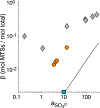Organosulfates from Dark Aqueous Reactions of Isoprene-Derived Epoxydiols Under Cloud and Fog Conditions: Kinetics, Mechanism, and Effect of Reaction Environment on Regioselectivity of Sulfate Addition
- PMID: 40290487
- PMCID: PMC12029931
- DOI: 10.1021/acsearthspacechem.0c00293
Organosulfates from Dark Aqueous Reactions of Isoprene-Derived Epoxydiols Under Cloud and Fog Conditions: Kinetics, Mechanism, and Effect of Reaction Environment on Regioselectivity of Sulfate Addition
Abstract
Atmospheric oxidation of isoprene yields large quantities of highly water-soluble isoprene epoxydiols (IEPOX) that partition into fogs, clouds, and wet aerosols. In aqueous aerosols, acid-catalyzed ring-opening of IEPOX followed by nucleophilic addition of inorganic sulfate or water forms organosulfates and 2-methyltetrols, respectively, contributing substantially to secondary organic aerosol (SOA). However, the fate of IEPOX in clouds, fogs and evaporating hydrometeors is not well understood. Here we investigate the rates, product branching ratios, and stereochemistry of organosulfates from reactions of dilute IEPOX (5 to 10 mM) under a range of sulfate concentrations (0.3 to 50 mM) and pH values (1.83-3.38) in order to better understand the fate of IEPOX in clouds and fogs. From these aqueous dark reactions of β-IEPOX isomers (trans- and cis-2-methyl-2,3-epoxybutane-1,4-diols), which are the predominant IEPOX isomers, products were identified and quantified using hydrophilic interaction liquid chromatography coupled to an electrospray ionization high-resolution quadrupole time-of-flight mass spectrometer operated in negative ion mode (HILIC/(-)ESI-HR-QTOFMS). We found that regiochemistry and stereochemistry were affected by pH and the tertiary methyltetrol sulfate (C5H12O7S) was promoted by increasing solution acidity. Furthermore, the rate constants for the reaction of IEPOX under cloud-relevant conditions are up to one order of magnitude lower than reported in the literature for aerosol-relevant conditions due to markedly different solution activity. Nevertheless, the contribution of cloud and fog water reactions to IEPOX SOA may be significant in cases of lower aqueous-phase pH (model estimate) or during droplet evaporation (not studied).
Keywords: 2-methyl-2,3-epoxybutane-1,4-diols; 2-methyltetrols; Biogenic-anthropogenic interaction; IEPOX; Molecular tracers; Multiphase chemistry; Stereochemistry; aqSOA.
Figures








Similar articles
-
Development of a hydrophilic interaction liquid chromatography (HILIC) method for the chemical characterization of water-soluble isoprene epoxydiol (IEPOX)-derived secondary organic aerosol.Environ Sci Process Impacts. 2018 Nov 14;20(11):1524-1536. doi: 10.1039/c8em00308d. Environ Sci Process Impacts. 2018. PMID: 30259953 Free PMC article.
-
Understanding the Early Biological Effects of Isoprene-Derived Particulate Matter Enhanced by Anthropogenic Pollutants.Res Rep Health Eff Inst. 2019 Mar;2019(198):1-54. Res Rep Health Eff Inst. 2019. PMID: 31872748 Free PMC article.
-
Isoprene Epoxydiol-Derived Sulfated and Nonsulfated Oligomers Suppress Particulate Mass Loss during Oxidative Aging of Secondary Organic Aerosol.Environ Sci Technol. 2022 Dec 6;56(23):16611-16620. doi: 10.1021/acs.est.2c03200. Epub 2022 Nov 15. Environ Sci Technol. 2022. PMID: 36378716
-
A review of stereochemical implications in the generation of secondary organic aerosol from isoprene oxidation.Environ Sci Process Impacts. 2016 Nov 9;18(11):1369-1380. doi: 10.1039/c6em00354k. Environ Sci Process Impacts. 2016. PMID: 27762408 Review.
-
Role of Carbon Dioxide, Ammonia, and Organic Acids in Buffering Atmospheric Acidity: The Distinct Contribution in Clouds and Aerosols.Environ Sci Technol. 2023 Aug 29;57(34):12571-12582. doi: 10.1021/acs.est.2c09851. Epub 2023 Aug 21. Environ Sci Technol. 2023. PMID: 37599651 Free PMC article. Review.
References
-
- IPCC, 2013: Summary for Policymakers. In: Climate Change 2013: The Physical Science Basis. Contribution of Working Group I to the Fifth Assessment Report of the Intergovernmental Panel on Climate Change [Stocker TF, Qin D, Plattner G-K, Tignor M, Allen SK, Boschung J, Nauels A, Xia Y, Bex V and Midgley PM (Eds.)]. Cambridge University Press, Cambridge, United Kingdom and New York, NY, USA.
- Clim. Change 2013 Phys. Sci. Basis Contrib. Work. Group Fifth Assess. Rep. Intergov. Panel Clim. Change 2013.
-
- Kreidenweis SM; Petters M; Lohmann U 100 Years of Progress in Cloud Physics, Aerosols, and Aerosol Chemistry Research. Meteorol. Monogr 2018, 59, 11.1–11.72. 10.1175/AMSMONOGRAPHS-D-18-0024.1. - DOI
-
- West JJ; Cohen A; Dentener F; Brunekreef B; Zhu T; Armstrong B; Bell ML; Brauer M; Carmichael G; Costa DL; Dockery DW; Kleeman M; Krzyzanowski M; Künzli N; Liousse C; Lung S-CC; Martin RV; Pöschl U; Pope CA; Roberts JM; Russell AG; Wiedinmyer C “What We Breathe Impacts Our Health: Improving Understanding of the Link between Air Pollution and Health”. Environ. Sci. Technol 2016, 50 (10), 4895–4904. 10.1021/acs.est.5b03827. - DOI - PubMed
-
- Zhang Q; Jimenez JL; Canagaratna MR; Allan JD; Coe H; Ulbrich I; Alfarra MR; Takami A; Middlebrook AM; Sun YL; Dzepina K; Dunlea EJ; Docherty KS; DeCarlo PF; Salcedo D; Onasch T; Jayne JT; Miyoshi T; Shimono A; Hatakeyama S; Takegawa N; Kondo Y; Schneider J; Drewnick F; Borrmann S; Weimer S; Demerjian K; Williams P; Bower K; Bahreini R; Cottrell L; Griffin RJ; Rautiainen J; Sun JY; Zhang YM; Worsnop DR Ubiquity and Dominance of Oxygenated Species in Organic Aerosols in Anthropogenically-Influenced Northern Hemisphere Midlatitudes. Geophys. Res. Lett 2007, 34 (13), L13801. 10.1029/2007GL029979. - DOI
Grants and funding
LinkOut - more resources
Full Text Sources
